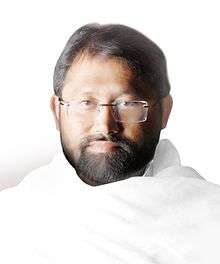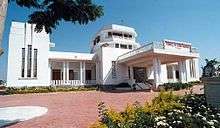Rakesh Jhaveri
| Rakesh Jhaveri | |
|---|---|
 | |
| Born |
September 26, 1966 Mumbai, Maharashtra, India |
| Nationality | Indian |
| Other names | Pujya Gurudevshri Rakeshbhai |
| Education | M. A., Ph. D. |
| Alma mater | Osmania University, University of Mumbai |
| Organisation | Shrimad Rajchandra Mission, Dharampur |
| Parents |
|
| Website |
www |
Rakesh Jhaveri, also known as Pujya Gurudevshri Rakeshbhai,[upper-alpha 1] (born 26 September 1966) is a spiritual leader, scholar of Jainism, author and orator from India. Spiritually inclined from the young age, he became a follower of Shrimad Rajchandra, a Jain spiritual teacher. He completed doctoral studies on Shrimad's work Atmasiddhi. He founded Shrimad Rajchandra Mission, Dharampur to support his spiritual and social activities.
Early life
Rakesh Jhaveri was born in Mumbai, India on 26 September 1966 to Dilip and Rekha Jhaveri, who followed the Shwetambara Murtipujaka tradition of Jainism.[1] In 1968, Sahaj Anandji, a monk from Rajasthan who had established Shrimad Rajchandra Ashram at Hampi, was at Palitana for religious discourses where his father was introduced to Sahaj Anandji by his maternal uncle. So his parents were influenced by Sahaj Anandji. Sahaj Anandji died in 1970 and was succeeded by Mataji.[2]
In 1972, Rakesh began his academic studies at Activity High School in Mumbai. From an early age, he was spiritually inclined. His mother and others have recounted miracles prior to and after his birth. He first encountered Shrimad Rajchandra's writing at the age of eight. He claimed that he had a jāti smaraṇa gnān (knowledge of previous lives) after seeing Shrimad's photograph then.[3] In 1978, Rakesh visited Hampi and stayed for eighteen months.[4] A satsang-mandal (devotional group) was formed by 1978 and some followers had already started to call him Guru by 1980.[5] During his visit to his aunt in Jaipur, he decided to devote rest of his life to spiritual activities.[5] In 1983, he visited Hampi again and stayed there for two years. There he was initiated by Mataji and was nominated as her successor.[4] In 1985, he returned to Mumbai upon his parents' request and started studying religious texts, practicing yoga and learning Indian classical music. He observed silence for twelve hours a day and traveled extensively between 1985 and 1990.[6][7] During this period, the number of followers around him continued to grow.[8] During his holidays in Nepal, he decided to pursue the college studies.[6]
He completed B. A. from Osmania University, Hyderabad, in 1988.[1] In 1989, he visited Antwerp for his father's treatment where his discourses were attended by increasing number of followers.[9] He completed M. A. in Philosophy in 1991 from the University of Mumbai.[7] He started his doctoral studies on Atmasiddhi, a spiritual work composed by Shrimad Rajchandra, in January 1994 under Ramanlal Shah. He was awarded Ph. D. on 2 December 1998 by the University of Mumbai.[10][7][1] He had vowed not to give a public discourse until his Ph. D. was completed. He gave his first public discourse in Rajkot on 13 April 2001.[10]
Spiritual life


Rakesh Jhaveri established Shrimad Rajchandra Adhyatmik Satsang Sadhana Kendra in 1994 to organise his followers which was later succeeded by the Shrimad Rajchandra Mission Dharampur. On 13 May 1999, the construction of an ashram spread across 223 acres at Dharampur was started[11][1] and was opened in April 2001. The ashram is located on the hillock of Mohangadh which was an estate of the last ruler of the erstwhile Dharampur State.[12] In 2002, he started initiating followers, Atmarpits, who give up worldly possessions and commit to celibacy.[7] He gives the series of discourses to his followers at the ashram throughout the year. He gives discourses in Mumbai once a month on Shrimad Rajchandra Vachanamrut, a compilation of Shrimad Rajchandra's letters, personal diaries and transcriptions of his spiritual discourses.[13][14] He also prescribes an annual scriptural study schedule to his followers.[15]
In November 2016, the Mission produced a play, Yugpurush: Mahatma na Mahatma depicting spiritual relationship between Shrimad Rajchandra and Mahatma Gandhi.[16] The Mission opened a science college in Dharampur, Shrimad Rajchandra Vidyapeeth, the same month.[17] In November 2017, the 34-feet tall statue of Shrimad Rajchandra was unveiled at the ashram.[18] By 2017, the Mission had 102 Satsang centres, 39 Youth Group Centres and 227 Divine Touch Centres worldwide.[19]
He established Shrimad Rajchandra Love and Care (SRLC); a non-profit that provides medical, educational and humanitarian services; in 2003.[20]
Personal life
Though he follows several principles of Jain monasticism, such as observing mahavratas (major vows), he does not consider himself a monk. He resides with his followers at the ashram in Dharampur and with his family when in Mumbai.[7]
Recognition
He was awarded the Gandhi Seva Medal by the Gandhi Global Family, an NGO, in 2017.[21]
Bibliography
- 2011 – A Life Worth Living - Inspiring seekers to lead a Meaningful life , 187 pp. ISBN 978-93-84405-47-2
- 2011 – Embark on the Inner Journey: Transformation through introspection , 217 pp. ISBN 978-93-84405-22-9
- 2012 – The Path Enlightened - Discovering the essence of religion, 179 pp. ISBN 978-93-84405-32-8
- 2012 – Seek Thy Eternal Self, 179 pp. ISBN 978-93-84405-19-9
- 2013 – Bliss Within - Shattering the illusion of false happiness,to attain true joy , 210 pp. ISBN 978-93-84405-48-9
- 2013 – Time to Awaken - "Guidance for bringing an end to transmigration and accelerating the journey to liberation, 219 pp. ISBN 978-93-84405-60-1
- 2014 – Shrimad Rajchandra - Saga of Spirituality, 275 pp. ISBN 978-81-929141-1-4
- 2015 – A Divine Union, 162 pp. ISBN 978-93-84405-65-6
- 2016 – Sadguru Insights: 50 Enlightening Lessons from the Master, 208 pp. ISBN 978-93-84405-67-0
Notes and references
| Wikimedia Commons has media related to Rakesh Jhaveri. |
Notes
- ↑ Pujya Gurudevshri and Bhai are honorifics. He is credited in his books by this name. He is also addressed as Bapaji or Sahebji by his followers.
References
- 1 2 3 4 Shweta. "Jain Saint Rakeshbhai Jhaveri: The True Successor of Shrimad Rajchandraji". Religion World. ReligionWorld.in. Retrieved 7 June 2018.
- ↑ Salter 2002, p. 101-102.
- ↑ Salter 2002, p. 104.
- 1 2 Salter 2002, p. 103.
- 1 2 Salter 2002, p. 105.
- 1 2 Salter 2002, p. 106-107.
- 1 2 3 4 5 Chhapia, Hemali (February 2013). "MBAs, doctors, engineers surrender soul to service and prayers". Times of India. Archived from the original on 2016-07-14. Retrieved 2014-02-24.
- ↑ Salter 2002, p. 106.
- ↑ Salter 2002, p. 107.
- 1 2 Salter 2002, p. 107-108.
- ↑ Salter 2002, p. 98.
- ↑ Salter 2002, p. 99.
- ↑ Salter 2002, p. 98-100.
- ↑ Salter 2002, p. 247.
- ↑ Salter 2002, p. 251.
- ↑ "Yugpurush: An Inspirational Story of Shrimad Rajchandraji". Janmabhoomi. Janmabhoomi. Archived from the original on 2016-11-18. Retrieved 18 November 2016.
- ↑ "Gujarat CM inaugurates Science College at Shrimad Rajchandra Vidyapith in Dharampur". CMO Gujarat. CMO Gujarat. Archived from the original on 2016-11-16. Retrieved 16 November 2016.
- ↑ Das, Preeti (4 November 2017). "34-feet statue of 'Mahatma's mentor' unveiled in Valsad". The Indian Express. Archived from the original on 2018-06-12. Retrieved 7 June 2018.
- ↑ "Modi Releases Commemorative Coins on 150th Birth Anniversary of Shrimad Rajchandra, Mahatma Gandhi's Spiritual Guide". India West. 14 July 2017. Archived from the original on 2018-07-05. Retrieved 6 June 2018.
- ↑ Reilly, Erin (Jul 30, 2017). "Indian charity comes to Parsippany and heads back". USA Today. The Daily Record. Retrieved 23 August 2017.
- ↑ "Gandhi Global Family awards the prestigious Gandhi Seva Medal to Pujya Gurudevshri". Shrimad Rajchandra Mission Dharampur. Shrimad Rajchandra Mission Dharampur. Archived from the original on 2017-11-10. Retrieved 9 November 2017.
Bibliography
- Salter, Emma (September 2002). Raj Bhakta Marg: the path of devotion to Srimad Rajcandra. A Jain community in the twenty first century (Doctoral thesis). University of Wales. pp. 98–107, 247, 251. Retrieved 2018-09-21 – via eprints.hud.ac.uk.